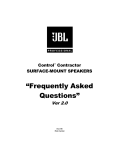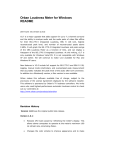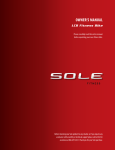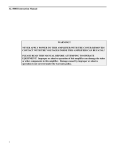Download Dorrough VLM-40 NTSC Instruction manual
Transcript
IR E U N IT S -40 -32 0 20 -48 40 60 80 100 120 LUMINANCE SYNC SYNC COMPOSITE VIDEO LUMINANCE METER SETUP © 1990 MODEL VLM-40 COMPOSITE VIDEO LUMINANCE METER MODEL VLM-40 NTSC TECHNICAL INSTRUCTION MANUAL VLM-40 NTSC TECHNICAL INSTRUCTION MANUAL INTRODUCTION EASY-TO-USE VIDEO LEVEL METER... SIMULTANEOUS DISPLAY... PEAK AND AVERAGE... SPECIFICATIONS... The DORROUGH Composite Video Luminance Meter, Model VLM-40, is a simple, easy-to-use, video level meter designed for quick dynamic measurements of video levels from any connected NTSC source (e.g., camera, VTR, etc.). Using a single 40-segment bar graph, the VLM-40 simultaneously displays three amplitude parameters of the composite video signal: sync, average luminance, and peak luminance. Two additional indicators detect the presence of proper sync and setup levels. Just like a traditional waveform monitor, the VLM-40’s peak-toaverage features enable you to quickly check lighting conditions, contrast, drop-outs, sync stability, and video signal quality. However, you’ll find it easier to use as you interpret data on the single meter scale. The VLM-40 is insensitive to chroma information, VITS (vertical interval test signals), and it responds to luminance signals as short as 200 ns in length. • INPUT IMPEDANCE 25 kΩ unterminated, 75 Ω terminated • SYNC RANGE -50 to -32 IRE units • LUMINANCE RANGE 0 to 120 IRE units • SYNC AND LUMINANCE FREQUENCY RESPONSE Exceeds IRE frequency response • MINIMUM PULSE WIDTH RESPONSE 200 ns • METER RESOLUTION Luminance scale is 4 IRE units; Sync scale is 2 IRE units • DIMENSIONS 8 1 ⁄ 4"W x 2 7⁄ 8"H x 6 1 ⁄ 2" D DORROUGH Electronics constantly strives to meet or exceed the highest professional standards. As a result of these efforts, modifications may be made from time to time to existing products without prior notice. Specifications and appearance may differ from those listed or shown in this manual. © DORROUGH Electronics, 1994 DORROUGH Electronics 5221 Collier Place Woodland Hills, CA 91364 USA Voice: 818•998•2824 – FAX: 818•998•1507 Introduction – 1 VLM-40 NTSC TECHNICAL INSTRUCTION MANUAL DESCRIPTION SIMULTANEOUS PEAK AND AVERAGE DISPLAY... The VLM-40 features a single 40-segment bar graph, as shown in Fig. 1. Peak and average luminance are simultaneously displayed on 30 LED segments over a range of 0 to 120 IRE units (for a resolution of 4 IRE units). Average luminance levels are indicated as a continuous bar, while peak levels are displayed as a single LED above the bar. Luminance levels in the 0 to 100 IRE range are displayed as green LED segments. Levels over 100 IRE use red indicators for increased recognition. IR E U NIT S -40 -32 0 20 40 60 80 100 -48 120 LUMINANCE SYNC SYNC SETUP COMPOSITE VIDEO LUMINANCE METER Fig. 1. The VLM-40’s 40-segment bar graph displays sync, average, and peak luminance video levels. SYNC AND SETUP VIOLATION LEDS... © 1990 MODEL VLM-40 Sync is displayed on one of ten yellow LED segments on an expanded scale ranging from -52 to -30 IRE units (for a resolution of 2 IRE units). A green LED indicates a proper sync level of -40 IRE. The front meter panel also includes sync and setup LEDs that detect the status of these corresponding video levels. Under normal operating conditions, the sync LED will be green whenever the video source has a proper sync signal. If sync drops out, the sync LED will flash red for single sync drop-outs greater than 2 H, or stay on full for continuous drop-outs. The setup LED is green whenever the video source has a Setup level greater than 7.5 IRE units, and red when setup goes below 4 IRE. The examples in the Operation chapter (starting on page 6) will explain how to use all these features in more detail. 2 – Description VLM-40 NTSC TECHNICAL INSTRUCTION MANUAL DESCRIPTION REAR PANEL CONNECTIONS.. As shown in Fig. 2, the VLM-40’s rear panel is equipped with BNC connectors for video and loop, and a switch for 75-ohm termination or loop connection. An ac power cord provides power to the unit from a standard 115 V ac receptacle. DORROUGH ELECTRONICS WOODLAND HILLS, CA 91364 Loop Through Fig. 2. The VLM-40’s rear panel provides video connections and a termination switch for 75 ohms or loop connection (Hi-Z). ABOUT THIS MANUAL... Term. Gain Hi-Z AC Cord The VLM-40 weighs less than two pounds, can be easily read from a distance of 20 feet, and may be installed in an optional panel mount (e.g., DORROUGH Rack Mount Kit, 40-S for a single meter or 40-D for dual meters) or operated as a standalone package. The remainder of this Technical Instruction Manual is divided into the following sections: Installation, Operation, Calibration, and Circuit Schematics. Before you install the unit, take a moment to read through the Operation chapter to fully understand the capabilities of the VLM-40. After you have determined how best to use the unit for your purposes, follow the instructions listed in the Installation chapter. Description – 3 VLM-40 NTSC TECHNICAL INSTRUCTION MANUAL INSTALLATION UNPACKING... Your unit was carefully packed at the factory. Nevertheless, please take a moment to examine it for any signs of shipping damage. If damage is evident, retain the carton and notify the transit carrier and your local distributor about your claim. Once you are satisfied with the physical integrity of the unit, follow the steps listed below to verify initial operation. INITIAL SET-UP... 1. The VLM-40 can either be mounted in a panel or operated as a stand-alone package. • To panel-mount the VLM-40, refer to Fig. 3 for mounting dimensions. Choose a ventilated area that provides a minimum depth of 10" for proper cable routing. 19.00 " 3.50 " IR E U N IT S 40 20 -32 0 -40 60 80 100 -48 120 LUMINANCE SYNC SYNC SETUP © 1990 COMPOSITE VIDEO LUMINANCE METER MODEL VLM-40 PANEL #40A-S 8.125 " PANEL #40A-D IR E U NIT S -40 -32 0 20 40 -48 3.00 " IR E U NIT S 60 80 100 -40 120 LUMINANCE -32 0 20 -48 SYNC 40 60 80 100 120 LUMINANCE SYNC SYNC COMPOSITE VIDEO LUMINANCE METER SETUP © 1990 SYNC MODEL VLM-40 COMPOSITE VIDEO LUMINANCE METER SETUP © 1990 MODEL VLM-40 6.50 " 16.250 " Fig. 3. Dimensions for mounting a VLM-40 in an optional Dorrough panel. • Consider a location that not only will offer easy observation of the meter movements, but will also allow convenient access to the back panel controls and proximity to a 120 Vac receptacle. • For stand-alone use, place the VLM-40 on any table top, counter, or cabinet near a 120 Vac receptacle. 4 – Installation VLM-40 NTSC TECHNICAL INSTRUCTION MANUAL INSTALLATION 2. After mounting or placing the unit, plug the ac cord into the ac receptacle and observe that the meter display on the front panel becomes backlit. NOTE: If backlighting is off, check your ac line for power, or test the internal 0.5 A fuse for continuity (see Schematics). 3. Connect a 75-ohm video cable from a standard television signal test generator to either video (BNC) connector on the back panel. Select Term. or Hi-Z to terminate the connection. 4. Feed a standard EIA split-field color bar signal with standard setup at 140 IRE (1 V p-p) to the VLM-40 and verify that the meter matches the reading shown in Fig. 4. IR E U NIT S -40 -32 0 20 40 60 80 100 -48 120 LUMINANCE SYNC SYNC SETUP COMPOSITE VIDEO LUMINANCE METER Fig. 4.VLM-40 display for standard EIA (split-field) color bar signal with standard setup at 140 IRE (1 V p-p). © 1990 MODEL VLM-40 NOTE: The VLM-40 is calibrated at the factory for standard video level of 1 V p-p. If your “house standard” is different value, use the video Gain potentiometer (see Fig. 2). This control will provide an adjustment range that accommodates signals down to 0.5 V p-p. 5. After completing steps 1 through 4 above, proceed to the Operation chapter to learn how to read the VLM-40 meter. Installation – 5 VLM-40 NTSC TECHNICAL INSTRUCTION MANUAL OPERATION In this section, you will learn how to interpret the readings on your VLM-40. As a study aid, a corresponding waveform monitor drawing accompanies each example illustration. COMPONENTS OF THE NTSC COMPOSITE VIDEO SIGNAL... The NTSC Composite Video Signal is a complex analog signal that contains luminance, color, and synchronizing signals. When we watch a picture on a television set, we are actually watching a variable-intensity electron beam tracing out a series of pictures on the light sensitive portion of a picture tube, as shown in Fig. 5. Fig. 5. The NTSC Composite Video signal contains two interlaced fields of 262.5 lines, for a total of 525 horizontal scan lines. The synchronization signals embedded in the television signal precisely instruct the electron beam to move across and down the picture tube to build a complete picture (using two fields) in 1 ⁄ 30 of a second. As the process repeats, our eyes do not see individual pictures or frames, but instead they blend the frames together so we perceive a moving picture. Examining a horizontal scan line in detail (as shown in Fig. 6 on the next page), we can see several important components of the ideal NTSC Composite Video Signal. A single horizontal scan line (1 H) has a duration of 63.5 µs. Horizontal sync is 4.7 µs long and extends from -40 to 0 IRE. Setup level for reference black is at 7.5 IRE, which provides a margin of safety for sync level. Peak white is at 100 IRE. Color burst is 2.5 µs long to provide color synchronization, and extends from -20 to +20 IRE on the front porch of the horizontal scan line. 6 – NTSC Composite Video Signal VLM-40 NTSC TECHNICAL INSTRUCTION MANUAL OPERATION IRE Units 120 color bars 100 Fig.6. A single horizontal scan line (75% full-field color bar signal) as seen on a waveform monitor. 80 luminance 60 40 2.5 µs 20 setup =7.5 color burst 0 -20 -40 sync 63.5 µs HOW TO READ THE VLM-40... The VLM-40 measures a NTSC Composite signal and displays its sync, average luminance, and peak luminance levels across a 40-segment bar graph. NOTE: The VLM-40 is set at the factory to measure active picture lines occurring after 21 lines of vertical blanking. For PAL/SECAM measurements, contact the the factory for information on the VLM-40 PAL/SECAM meter. 1. Using a standard television test signal generator, feed a 75% full-field NTSC color bar signal with standard setup at 115 IRE p-p to the VLM-40. Set the filter to low-pass to attenuate the chroma signal from the waveform display. 2. Study and compare the VLM-40 and waveform monitor illustrations shown in Fig. 7 on the next page. Reading The VLM-40 – 7 VLM-40 NTSC TECHNICAL INSTRUCTION MANUAL OPERATION IRE Units IR E U N IT S -40 20 -32 0 40 60 80 100 100 -48 120 LUMINANCE 80 SYNC SYNC 60 SETUP © 1990 COMPOSITE VIDEO LUMINANCE METER MODEL VLM-40 40 20 Fig. 7. VLM-40 and waveform monitor each show a 75% full-field color bar signal at 115 IRE p-p with low-pass filter on. On the VLM-40, three video levels are displayed: sync = - 40 IRE, average luminance = 40 IRE, and peak luminance = 76 IRE (75 actual). The total of the sync and peak luminance excursions equals 115 IRE. The sync LED is green and the setup LED is green. SYNC LEVELS... setup = 7.5 0 -20 -40 Sync level is displayed (left corner of VLM-40) as a single lit green LED within a range of ten yellow LED segments from -52 to -32 IRE. Each LED equals 2 IRE units. The indicated value corresponds to the value of the sync tip on a waveform monitor, as shown in Fig. 8. NOTE: A sync LED provides a simple presence/absence indicator of sync levels. The thresholds are: Sync Level Sync LED Color -52 to -32 IRE Green -32 IRE or higher Red No Sync Red IRE Units IR E U N IT S -40 -32 0 20 -48 40 60 80 100 100 120 LUMINANCE 80 SYNC SYNC COMPOSITE VIDEO LUMINANCE METER 60 SETUP © 1990 MODEL VLM-40 40 20 setup = 7.5 0 Fig. 8. Sync level on the VLM-40 corresponds to sync tip on the waveform monitor. 8 – Reading The VLM-40 -20 -40 VLM-40 NTSC TECHNICAL INSTRUCTION MANUAL OPERATION AVERAGE LUMINANCE... Average luminance is displayed as a continuously-lit green bar on the VLM-40. Each LED equals 4 IRE units. Average luminance is equal to the largest valued LED on the right end of the bar, as shown in Fig. 9. The indicated value corresponds to the average (calculated) luminance level on a waveform monitor. IRE Units IR E U N IT S -32 0 -40 20 40 60 80 100 100 -48 120 LUMINANCE 80 SYNC SYNC 60 SETUP © 1990 COMPOSITE VIDEO LUMINANCE METER MODEL VLM-40 40 20 average luminance = area under curve setup = 7.5 0 Fig. 9. The average luminance level on the VLM-40 corresponds to the average (calculated) luminance level on a waveform monitor. PEAK LUMINANCE... -20 -40 Peak luminance below 100 IRE is displayed as a single lit green LED to the right of the continuously-lit bar on the VLM-40. Values above 100 IRE are red. The indicated value corresponds to the value of peak luminance on a waveform monitor, as shown in Fig. 10. NOTE: The VLM-40 is very sensitive to measuring noise in the luminance signal and will respond to short impulses that may be undetected on a standard waveform monitor. IRE Units IR E U N IT S -40 -32 0 20 -48 40 60 80 100 100 120 LUMINANCE 80 SYNC SYNC COMPOSITE VIDEO LUMINANCE METER 60 SETUP © 1990 MODEL VLM-40 40 20 setup = 7.5 0 Fig. 10. The peak luminance level on the VLM-40 corresponds to the peak luminance level on a waveform monitor. -20 -40 Reading The VLM-40 – 9 VLM-40 NTSC TECHNICAL INSTRUCTION MANUAL OPERATION SETUP LEVEL... The setup LED is a two-way indicator of setup levels, as shown in Fig.12. The thresholds are: Setup Level Setup LED Above 7.5 IRE Green 7.5 to 4.0 IRE Green Below 4.0 IRE Red IRE Units IR E U N IT S -40 -32 0 20 -48 40 60 80 100 100 120 LUMINANCE 80 SYNC SYNC COMPOSITE VIDEO LUMINANCE METER 60 SETUP © 1990 MODEL VLM-40 40 20 setup = 7.5 0 Fig. 11. The SETUP LED on the VLM-40 corresponds to the setup level on a waveform monitor. 10 – How To Read The VLM-40/Examples -20 -40 VLM-40 NTSC TECHNICAL INSTRUCTION MANUAL OPERATION The following examples illustrate how you can use the VLM-40 to identify common problems that may occur in an NTSC composite video signal. EXAMPLE VLM-40 READINGS... MISSING SYNC PULSES IRE Units 100 IR E U N IT S -40 -32 0 20 40 60 80 80 100 -48 120 LUMINANCE 60 SYNC 40 SYNC SETUP © 1990 COMPOSITE VIDEO LUMINANCE METER MODEL VLM-40 20 setup = 7.5 0 Fig. 12. On the VLM-40, the sync LED flashes red each time a sync pulse is missing. You may not easily detect this fault using a waveform monitor. NOTE: With a complete loss of sync, the meter will not operate. LOW SYNC LEVEL -20 -40 IRE Units 100 IR E U N IT S -40 -32 0 20 -48 40 60 80 80 100 120 LUMINANCE 60 SYNC 40 SYNC COMPOSITE VIDEO LUMINANCE METER SETUP © 1990 MODEL VLM-40 20 setup = 7.5 0 Fig. 13. On the VLM-40, the sync LED is red. Sync bar graph has no lit segments. The waveform monitor shows no sync pulse. -20 -40 Examples – 11 VLM-40 NTSC TECHNICAL INSTRUCTION MANUAL OPERATION SETUP LEVEL VIOLATION IRE Units 100 IR E U N IT S -40 -32 0 20 40 60 80 80 100 -48 120 LUMINANCE 60 SYNC 40 SYNC SETUP © 1990 COMPOSITE VIDEO LUMINANCE METER MODEL VLM-40 20 setup = 7.5 0 Fig. 14. On the VLM-40, the setup LED is red. On the waveform monitor, the setup level is less than 4 IRE. EXCESSIVE PEAK LUMINANCE -20 -40 IRE Units 100 IR E U N IT S -40 -32 0 20 -48 40 60 80 80 100 120 LUMINANCE 60 SYNC 40 SYNC COMPOSITE VIDEO LUMINANCE METER SETUP © 1990 MODEL VLM-40 20 setup = 7.5 0 Fig. 15. On the VLM-40, average luminance levels are at acceptable levels, but the red peak LED indicates peak luminance levels are above 100 IRE. This condition frequently occurs in a scene when light is reflected (e.g., jewelry) or there is external noise. Depending on the duration of the peak signal, you may not easily see these waveform excursions on a waveform monitor. 12 – Examples -20 -40 VLM-40 NTSC TECHNICAL INSTRUCTION MANUAL OPERATION POOR CONTRAST IRE Units 100 IR E U N IT S -40 -32 0 20 -48 40 60 80 80 100 120 LUMINANCE 60 SYNC 40 SYNC COMPOSITE VIDEO LUMINANCE METER SETUP © 1990 MODEL VLM-40 20 setup = 7.5 0 Fig. 16. On the VLM-40, the average luminance levels are below 40 IRE and the peak LED indicates peak luminance levels are at 60 IRE. The waveform monitor shows peak luminance levels just above 60 IRE, but calculating an average luminance level is difficult at best. For example, there may be white in the picture which will not appear on the waveform monitor. With the VLM-40, you can safely increase the overall video level by 10 IRE and still adhere to proper NTSC levels. -20 -40 Examples – 13 VLM-40 NTSC TECHNICAL INSTRUCTION MANUAL CALIBRATION NTSC CALIBRATION... The VLM-40 has been carefully calibrated for NTSC operation at the factory. However, the procedure is listed here for your future use. NOTE: The VLM-40 is only as accurate as the waveform generator you are using. Check sync and raster amplitudes before beginning calibration. 1. With the power off, remove the bottom four screws and lift off the enclosure to expose the circuit board, as shown in Fig. 17 (on the next page). 2. Connect a waveform generator to the VLM-40 video input and turn on the termination switch, SW1. Set the waveform generator to split-field bar pattern (100% white flag). 3. Apply power to the VLM-40. Adjust the rear panel input level control VR 13 so that the 100 IRE peak dot LED is lit. Verify that the -40 IRE sync amplitude LED is lit. 4. Select the full-field white raster waveform (100% white) on the generator. On the main board, adjust the average calibration control VR 36 so that the 100 IRE average bar LED is lit. 5. Select the stairstep waveform on the generator. Verify that the set-up LED on the VLM-40 is now lit red, indicating a set-up violation. 6. Disconnect the waveform generator from the VLM-40. Verify that both the sync and set-up error LEDs are red, and that the main display is blanked. 7. Turn off power and reassemble the unit. 14 – Calibration VLM-40 NTSC TECHNICAL INSTRUCTION MANUAL CALIBRATION U7 VR36 TRANSFORMER U3 J2 J1 SW1 VR13 Fig. 17. This simplified circuit board diagram shows key components used to calibrate the VLM-40 for NTSC operation. Calibration – 15

























